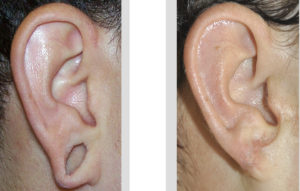Earlobe repairs are often quite simple and use standard techniques for slits and tear deformities. The gauged ear, however, is a different matter. Gauges, also known as tunnels, cogs, caps or plugs, create a considerable tissue expansion of the earlobe and require a more sophisticated approach to repair.
Younger men with gauged ears are increasingly requesting earlobe repair. This is usually so that they can enroll in the military. If not for this concern, many simply remove the earlobe device and let it shrink and contract with a resulting earlobe deformity.

In significant ear gauges, a completely normal earlobe may not be possible to get. Usually the earlobe will be a little smaller. But I prefer a well-shaped earlobe that is smaller than one that is more normal in size but has an elongated appearance.
Dr. Barry Eppley
Indianapolis, Indiana


